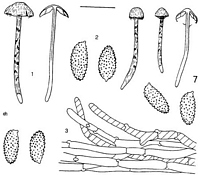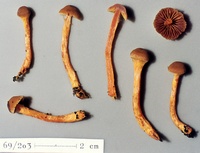|
 Dermocybe aurantiella Dermocybe aurantiella
BiostatusPresent in region - Indigenous. Endemic
Images (click to enlarge)
Caption: Dermocybe aurantiella: 1. carpophores. - 2. spores. - 3. basidia. - 4. cheilocystidia. - 5. pileipellis. | 
Caption: ZT69-203 , Holotype
Owner: E. Horak: © Creative Commons Attribution-Noncommercial 3.0 New Zealand |
Article: Horak, E. (1988) [1987]. New species of Dermocybe (Agaricales) from New Zealand. Sydowia 40: 81-112.
Description: Pileus -20 mm, hemispherical to convex becoming broadly campanulate, centre flat to subdepressed in aged specimens, margin incurved; orange, later turning argillaceous brown; dry, hygrophanous, margin non-striate, covered with coarse concolorous fibrils, margin appendiculate from orange veil remnants. - Lamellae 8-12, -3, adnate to emarginate; pale orange turning rust brown, edges entire, concolorous. - Stipe-55 x -3 mm, cylindrical; rarely subfusoid with tapering base; brilliant orange to saffron yellow; dry, below cortina zonate from numerous concolorous appressed belts of veil, hollow, single. - Context orange. - Odour and taste raphanoid. - Chemical reactions on pileus: KOH - pale olive; HCl, NH3 - negative.
Spore print rust brown. - Spores 8.5-11 x 4.5-5.5 µm, subcylindrical to slender amygdaliform, minutely warted, rust brown. - Basidia 30-2 x 6-7 µm, 4-spored. - Cystidia none. - Pileipellis a cutis composed of cylindrical hyphae (8-12 µm diam.), membranes not gelatinised, with yellow plasmatic pigment dissolving in KOH. - Clamp connections present.
Habitat: On soil among litter in Nothofagus-forest. - New Zealand.
Notes: The orange to yellow carpophores of D. aurantiella resemble small specimens of D. canaria but differ by the olive KOH reaction on the pileus and the verrucose, ± amygdaliform spores. Nothing is known yet about the chemical nature and structure of the pigments.
|